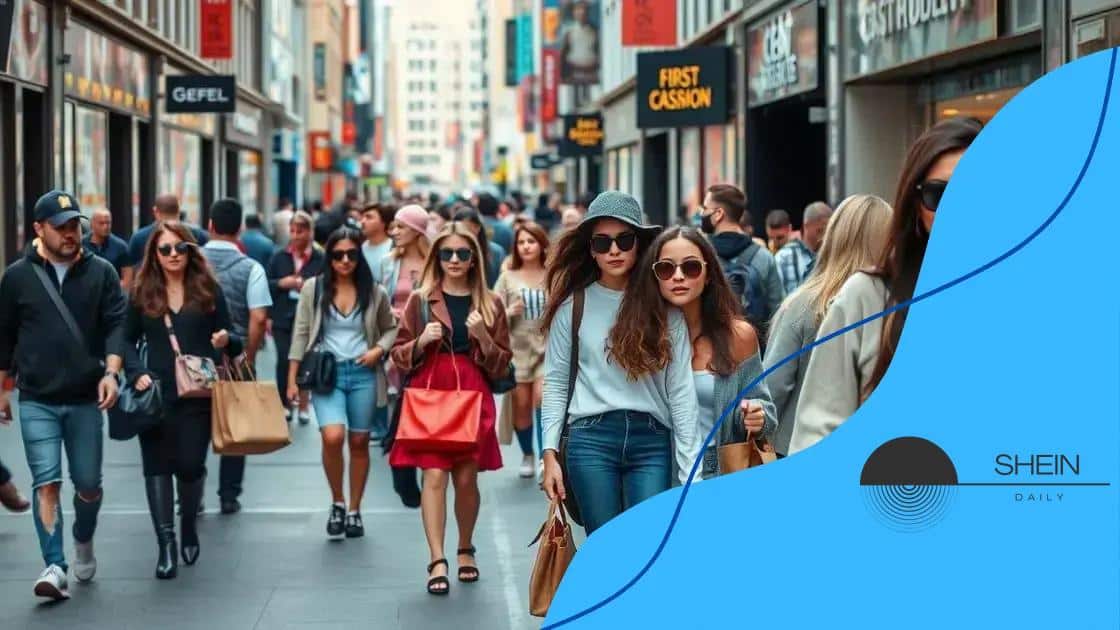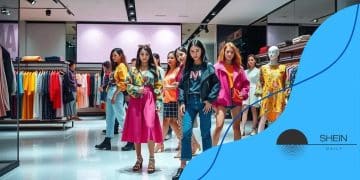Shein’s impact on global fashion retail trends

Shein’s impact on global fashion retail trends is marked by rapid production, affordable pricing, and increasing sustainability concerns, compelling retailers to adapt their strategies to meet evolving consumer demands.
Shein’s impact on global fashion retail trends is not just a fleeting moment; it’s reshaping the industry as we know it. Have you ever wondered how a brand can revolutionize an entire market in just a few years? Let’s dive into this intriguing phenomenon.
Understanding Shein’s business model
Understanding Shein’s business model is crucial to grasping its success in today’s fashion world. This brand has created a unique way to connect with consumers and tailor products to their needs.
One of Shein’s core strengths lies in its use of data analytics. By closely monitoring fashion trends and customer preferences, Shein can quickly adjust its inventory. This allows it to deliver the latest styles at a rapid pace. In fact, the brand launches new items daily, making it a top choice for trend-driven shoppers.
Key Features of Shein’s Model
Several components make up Shein’s innovative business approach:
- Fast Fashion Production: Shein produces affordable clothing quickly, enabling it to keep up with changing trends.
- Diverse Product Range: The brand offers a wide variety of products, ensuring there’s something for everyone.
- Engaging Marketing Strategies: Social media plays a significant role in Shein’s outreach, often collaborating with influencers to reach younger audiences.
The combination of fast fashion, diverse offerings, and active marketing ensures Shein remains relevant. This model not only attracts frequent visits from customers but also inspires loyalty through affordable pricing.
Furthermore, Shein leverages social media feedback to curate its collections. This interaction helps maintain a continuous cycle of consumer interest. Their marketing tactics adapt quickly to what customers want, emphasizing on styles trending in various online platforms. As a result, the brand thrives on its ability to evolve with its audience.
The rise of fast fashion in consumer preferences
The rise of fast fashion in consumer preferences has significantly transformed the apparel industry. With brands like Shein leading the way, shoppers now seek trendy and affordable clothing at an incredible pace.
One major factor contributing to this shift is the demand for quick access to the latest styles. Consumers want to express their individuality without breaking the bank. Fast fashion meets this need by offering new collections almost weekly, keeping the style fresh and exciting.
Driving Factors Behind Fast Fashion Growth
Several elements drive the increasing popularity of fast fashion:
- Affordability: Fast fashion is often cheaper than traditional retail options, allowing customers to buy more for less.
- Variety: These brands provide a vast selection of items, catering to various tastes and preferences.
- Sustainability Awareness: Though some argue fast fashion harms the environment, brands are starting to respond by implementing more sustainable practices.
Additionally, social media plays a critical role in spreading trends rapidly. Influencers promote the latest styles, making them accessible to millions almost instantly. As a result, consumers feel pressured to keep up with what is trending, reinforcing the desire for fast fashion.
Moreover, the emphasis on immediacy creates a ‘buy now’ mentality. Shoppers often purchase items impulsively, rather than considering long-term value. This behavior further fuels the popularity of fast fashion, as online retail platforms make it easier than ever to satisfy wardrobe needs in a flash.
As fast fashion continues to dominate, brands must strike a balance between keeping up with trends and addressing the growing concern for ethical production. Innovations in supply chain efficiency allow companies to respond quicker, yet maintaining quality is crucial to customer satisfaction. This intricate dance between speed and responsibility defines today’s fast fashion landscape.
How Shein is changing online shopping

How Shein is changing online shopping can be seen in several impactful ways. This brand has revolutionized the way consumers interact with fashion online, making the shopping experience faster and more personalized.
One significant change is the integration of technology into the shopping process. Shein uses data analytics to track customer preferences and behavior. By understanding what shoppers like, the platform can recommend items tailored to individual tastes. This personalized approach keeps customers engaged and returning for more.
Innovative Features of Shein’s Shopping Experience
Several innovative features help enhance online shopping:
- User-Friendly Interface: The Shein app and website are designed to be intuitive, allowing easy navigation to find products.
- Frequent Discounts: Special promotions and discounts attract price-sensitive consumers, encouraging impulse buying.
- Community Engagement: Shein has built a strong online community where users can share outfits and provide reviews, fostering a sense of belonging.
The combination of these features creates a unique online shopping environment. Consumers feel empowered by the affordability and accessibility of trendy clothing. Additionally, Shein has capitalized on social media to showcase its products through user-generated content, which drives organic traffic to its site.
Moreover, the concept of flash sales and limited-time offers creates a sense of urgency. Shoppers feel the need to act quickly so they don’t miss out on fashion they love. This tactic keeps the excitement alive, motivating consumers to make quicker purchasing decisions.
With fast shipping options and easy returns, Shein has effectively tackled common online shopping barriers. This convenience makes it more appealing than traditional brick-and-mortar stores. Consumers can shop anytime, anywhere, adding to the allure of online fashion retail.
Sustainability concerns in Shein’s practices
Sustainability concerns in Shein’s practices are becoming increasingly important in today’s fashion dialogue. As the brand rises in popularity, conversations around its impact on the environment gain traction.
One major issue is the environmental footprint of fast fashion. The production processes often involve high levels of waste and resource use. Fast fashion brands, including Shein, can contribute to this problem by promoting a throwaway culture, encouraging consumers to buy more often and dispose of clothing quicker.
Areas of Concern
Several key areas highlight the sustainability issues associated with Shein:
- Overproduction: The rapid cycle of design to sale often results in excess inventory that may end up in landfills.
- Material Choices: Many products are made from synthetic fabrics that are not biodegradable, leading to long-lasting waste in the environment.
- Water Usage: The fashion manufacturing process usually requires significant amounts of water, which can strain local water supplies.
Additionally, the brand has faced criticism regarding labor practices in its supply chain. Concerns about worker conditions in factories are prevalent as the demand for low-cost clothing rises. Many consumers are now questioning how and where their clothes are made, pushing brands to be more transparent.
Despite these issues, Shein is beginning to respond to sustainability concerns. Recently, the brand has announced initiatives aimed at reducing waste and improving practices. This includes plans to use more sustainable materials and implementing recycling programs. As consumers grow increasingly conscientious about sustainability, pressure on the brand to improve its practices continues to mount.
By becoming more aware of sustainability, shoppers are influencing brands to adopt better practices. Shein must balance its fast fashion model with environmentally friendly initiatives to remain relevant and responsible.
Future outlook for fashion retailers influenced by Shein
The future outlook for fashion retailers influenced by Shein highlights significant changes in the industry. As Shein’s model continues to gain traction, other retailers must adapt to stay competitive.
One major shift is the emphasis on speed. Retailers are learning the importance of quickly responding to trends. Shein’s ability to launch new styles rapidly sets a standard that others now feel pressured to meet. This has led to an increased focus on efficiency in supply chains.
Key Trends Shaping the Fashion Retail Landscape
Several trends are emerging as retailers adapt to the influence of Shein:
- Increased Use of Technology: Many brands are adopting technological solutions like AI and data analytics to better understand consumer preferences.
- Sustainability Initiatives: As consumers demand more sustainable practices, retailers are exploring eco-friendly materials and ethical production methods.
- Personalized Shopping Experiences: Tailoring recommendations based on customer behavior is becoming more common as brands strive for deeper connections with their audiences.
Additionally, collaboration with influencers and social media engagement is becoming essential. Brands see the value in creating communities around their products. As Shein continues to thrive through influencer marketing, other retailers recognize the need to build their own relationships with social media personalities.
Moreover, the notion of direct-to-consumer (DTC) sales is rising. Consumers gravitate toward companies that engage directly with them. This allows brands to manage relationships more effectively and streamline their marketing efforts.
As traditional retail models evolve, the challenge lies in balancing speed and quality. Customers expect fashionable looks delivered promptly, but they also desire products that last. This balancing act will define the future of fashion retail and how brands respond to the Shein phenomenon.
FAQ – Frequently Asked Questions About Shein’s Impact on Fashion Retail
How has Shein influenced the speed of fashion retail?
Shein has set a standard for rapid production cycles, encouraging other retailers to launch new styles quickly and keep up with consumer trends.
What sustainability concerns are associated with Shein?
Shein faces criticism for its environmental impact, particularly related to overproduction, waste, and the materials used in its clothing.
How does Shein promote its products?
Shein leverages social media and influencers to showcase its latest styles and engage with a large audience, creating buzz around its products.
What trends are shaping the future of fashion retail due to Shein?
The future of fashion retail is focusing on technology integration, sustainable practices, and personalized shopping experiences driven by consumer demand.





